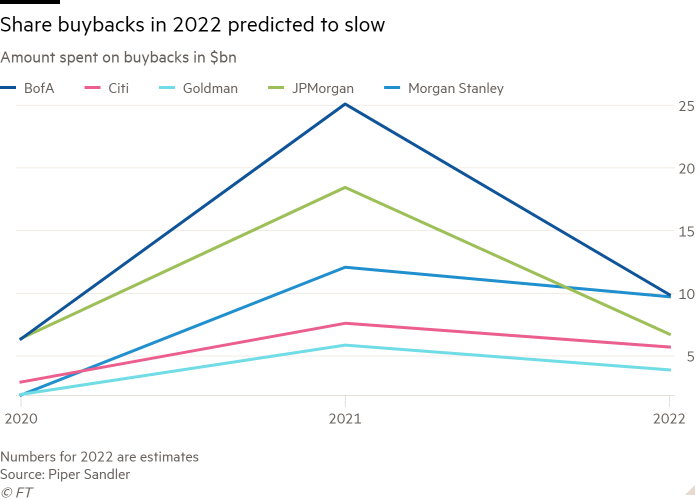The ability of the largest US banks to withstand a severe economic downturn will be in focus this week as the Federal Reserve publishes the results of the industry’s annual stress tests, amid growing fears of a recession.
The test, which runs through a series of doomsday scenarios for 34 banks including Goldman Sachs and JPMorgan Chase, is a crucial gauge of financial strength and helps determine how much capital lenders will be able to put towards dividends or share buybacks.
“That’s what the stress test is always meant to capture. What’s different and new is that now [a downturn] feels like it might be upon us,” said Oppenheimer & Co banking analyst Chris Kotowski.
US subsidiaries of foreign banks with significant American investment banking operations are also subject to the Fed stress test. Industry observers are paying particular attention to Credit Suisse, which was put on a watchlist of institutions requiring tougher supervision by the UK financial regulator, the FT reported this month.

The results of the US test, which is a requirement of the post-crisis Dodd-Frank financial regulations, are due on June 23.
To “pass”, banks must show they have capital levels above the government-mandated minimums after enduring hypothetical scenarios the Fed outlined in February, including a nearly 40 per cent decline in commercial real estate prices, a 10 per cent unemployment rate and heightened stress in the corporate debt market.
The exercise will determine the so-called stress-test capital buffer for the largest US banks — the amount of high-quality common equity tier one capital, or CET1, they will have to hold relative to their risk-weighted assets in excess of regulatory minimums. This CET1 ratio is a crucial benchmark of financial stability.
Banks, which typically aim to keep a capital buffer above the amount mandated by regulators, can publicly confirm their stress-capital buffer and reveal their shareholder return plans on June 26, two days after the results.

“I do think this stress test has the potential to prove that the industry is well-positioned to handle a very devastating scenario, something much worse than anyone’s predicting,” said Jason Goldberg, banking analyst at Barclays.
As long as banks are above their capital requirements they are free of Fed restrictions on how much of their capital they can put towards shareholder dividends and stock buybacks.
Unlike last year’s stress tests, which acted as catalysts for higher dividends and large stock buyback programmes, analysts expect banks will be more cautious in returning capital to shareholders given the uncertain economic conditions. Last year, losses on loans during the coronavirus pandemic were also much lower than banks had anticipated, enabling them to return more capital to shareholders.
Analysts expect dividends to tick up this year but predict the pace of share buybacks at the biggest banks will slow.
“If anything, with economic uncertainty you probably want to start building capital,” said Jeff Harte at Piper Sandler.
Jefferies analysts forecast that of the six largest US banks by assets — JPMorgan, Bank of America, Citigroup, Wells Fargo, Goldman and Morgan Stanley — all except Morgan Stanley will increase or maintain their current CET1 ratios by the end of 2023, according to Jefferies estimates.
Bank stocks have fallen by slightly more than the broader market so far this year, as worries over a recession have made investors more pessimistic about the outlook for bank earnings.
However, top executives at Capital One, Huntington Bancshares and Fifth Third Bancorp struck an optimistic tone at an industry conference last week. With unemployment low and consumers sitting on bigger bank deposits than before the Covid-19 pandemic, credit quality remained strong and losses on consumer loans were low, they said.
James Gorman, chief executive of Morgan Stanley, which Barclays estimates will buy back about $7.5bn of its own stock in the 12 months after the stress test results, last week described the buying opportunity at the current stock price as “a gift from heaven”.
Source: https://www.ft.com/cms/s/c4dda7ee-a5b9-4d33-b27c-06067a4a5f34,s01=1.html?ftcamp=traffic/partner/feed_headline/us_yahoo/auddev&yptr=yahoo
